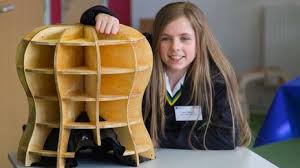There have been spectacular headlines about 3D technology, comprising ideas to utilize 3D printers to build clothes, firearms and the parts of house. It is also making the impact on education, with plans to put 3D printers into schools in United Kingdom and United States.
These technologies hold huge potential for young people both in and out of school. Schools are getting interested in "rapid prototyping" technology. But there are still usual barriers - access, funding, teacher awareness and confidence. Though, many learners are getting 3D design whether or not their schools are ready.

One of the most informative advocates is 14-year-old schoolgirl from Manchester in UK. Amy Mather won European Commission's first European Digital Girl of Year Award last year.Schoolgirl has presented her ideas in front of expert audiences, comprising Campus Party at London's O2 Arena, Wired Next Generation and Royal Society for encouragement of Arts (RSA).
'Digital maker' movement
Amy got involved in coding and later 3D design after attending Manchester Science Festival. But main inspiration for her work has been what is insecurely termed "digital maker" movement, global drive to give confidence to young people to be creative with technology. This comprises support from Fab Lab in Manchester. The full form of "Fab lab" is "fabrication laboratory", where digital ideas are curved into prototypes and products.
Amy Mather, Campus Learning from young: Amy Mather illustrates her ideas on 3D printing
Fab Lab holds open days for public and these permitted Amy to utilize software and hardware not available in school, like 3D printers and laser cutters. She utilizes 3D design and producing techniques for her school GCSE product design coursework.
'Fab Labs'
Manchester's Fab Lab was first of nine in UK, with number expected to rise to 30 in three years. They are part of global project which started in US, growing from university course, "How To Make (approximately) Anything". Pretoria Students in Pretoria have developed their own 3D printer for schools. In 8 years of publishing his seminal book, Fab: Coming Revolution on Your Desktop - from Personal Computers to Personal Fabrication, there are now around 200 Fab Labs in more than 40 countries.
Challenge for Fab Labs, he says, is to attach "inventive power of the world" and to apply it to "create and make solutions to local problems". Fab Labs serve both education and business as places where interested parties can come together to work with technology. And Prof Gershenfeld is vocal in resisting media's hyping of 3D printing.
Three-dimensional DIY
Why linger for access to 3D printer if you can utilize other methods for construction? She explains how she utilized 3D design software to make her own flat-pack version of stool - and then utilized machine to cut out pieces so that she can collect final product. 3D printing facade of future: 3D printing is varying design process for students. She has utilized laser cutter technology to make cases for computers she utilizes for her projects and has even utilized 3D printer to create a vacuum-formed chocolate mould for friend's birthday party. Unluckily edges were too sharp, she admits. "But I will try again with thicker, food-safe plastic."
"Most of software is very easy to employ, very intuitive. With just couple of online tutorials, it is actually easy to learn how to get around it." There are free, open-source systems which permit pupils to cut from flat sheet and then assemble 3D model. This enhanced ease of use and lower pricing. "We can recycle cola and soft drinks bottles to build 3D printing filament as raw material for our machine," they say. "We can even use that material to 3D print the prosthetic arm."
3D printing goes freehand
Amy Mather is observance the close eye on new developments. She is presently taken with notion of freehand 3D printing being offered by the new invention, 3Doodler, that is described as "the world's first 3D printing pen". It does not require a computer or printer. "You put plastic rods in it and it works bit like a glue gun." It heats up plastic and extrudes it through its nib and you can sketch 3D items with it. You can either make it first on the flat surface and then assemble it, or you can make straight up into air. It is good for rapidly prototyping ideas and being creative but it is nowhere near as expensive as 3D printer and you do not have to have knowledge of any CAD [computer aided design] software. You can simply get on with it and do what you like, change and modify colours and things. Her next ambition is trying to set up her own "Mini Maker Faire", in this case a Mini Mini Maker Faire.